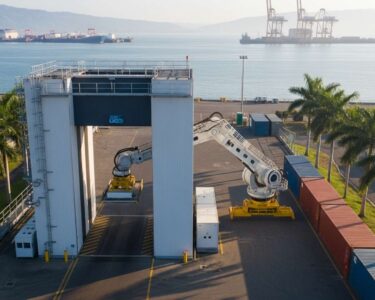Puntarenas, Costa Rica — PARRITA, Puntarenas – A harrowing situation at Playa Palo Seco this past weekend concluded with a successful rescue, highlighting the effectiveness of Costa Rica’s emergency response network. A 67-year-old Italian tourist was saved by the National Coast Guard Service after being pulled out to sea by a powerful rip current.
The incident began when the tourist, identified only as Mr. Defrancesco, found himself in distress, unable to overcome the strong offshore pull of the current. An urgent alert was dispatched to the 9-1-1 Emergency Line, which serves as the central nervous system for coordinating rapid response across the country. This critical call immediately triggered the deployment of a Coast Guard vessel stationed in the area.
To better understand the legal framework surrounding tourist safety and the liabilities involved in rescue operations, TicosLand.com consulted with Lic. Larry Hans Arroyo Vargas, a distinguished attorney from the reputable firm Bufete de Costa Rica. His expertise provides critical insight into the responsibilities of both tour operators and tourists themselves.
While tourists inherently assume a certain level of risk when engaging in adventure activities, this does not absolve tour operators of their duty of care. Costa Rican law requires providers to maintain stringent safety protocols, provide clear warnings, and ensure their staff is adequately trained for emergencies. Any proven negligence in these areas can lead to significant civil liability, reinforcing the principle that a safe experience is a non-negotiable component of the service offered.
Lic. Larry Hans Arroyo Vargas, Attorney at Law, Bufete de Costa Rica
This legal clarification is essential, reinforcing that the thrill of adventure in Costa Rica is built upon a non-negotiable foundation of safety and accountability. The duty of care is not merely a recommendation but a legal cornerstone of our tourism industry, ensuring that a memorable experience is also a secure one. We sincerely thank Lic. Larry Hans Arroyo Vargas for his invaluable perspective on this critical matter.
The swift mobilization of the maritime unit proved crucial. Officers navigated to the tourist’s last known location and, thanks to their training and expertise, were able to spot him in the water. The rescue operation was executed efficiently, with the officers pulling Mr. Defrancesco from the ocean and bringing him safely aboard their vessel. The entire event underscored the readiness of the Coast Guard to handle life-threatening maritime emergencies.
Playa Palo Seco, like many beaches along Costa Rica’s stunning Pacific coastline, is known for its beauty but also for its potentially dangerous marine conditions. Rip currents are a common phenomenon in these waters. They are fast-moving channels of water that flow away from the shore, often catching even experienced swimmers by surprise. Experts advise that if caught in a rip current, one should not fight it directly but swim parallel to the shore until free from its pull.
Once back on solid ground, Mr. Defrancesco was met by a team from the Costa Rican Red Cross. Paramedics conducted an immediate medical evaluation to assess his condition after the ordeal. Fortunately, the responders confirmed that despite the dangerous circumstances, the tourist was in good health and did not require hospitalization, a testament to the speed of the rescue operation.
This successful outcome serves as a powerful reminder of the importance of inter-agency cooperation. The seamless communication between the 9-1-1 dispatch, the on-the-ground action by the National Coast Guard Service, and the post-rescue care provided by the Costa Rican Red Cross demonstrates a robust system designed to protect both citizens and the millions of tourists who visit the nation’s beaches each year.
The National Coast Guard Service operates under the Ministry of Public Security and plays a vital role beyond search and rescue missions. Its responsibilities include combating illegal fishing, drug trafficking, and protecting the country’s vast and biodiverse marine territories. Their presence along the coast is a critical component of both national security and public safety, ensuring that visitors can enjoy the natural wonders of Costa Rica with confidence.
As the tourism sector continues to be a cornerstone of the Costa Rican economy, incidents like this, which end positively, reinforce the country’s reputation as a safe and well-prepared travel destination. For beachgoers, it is a crucial lesson in respecting the power of the ocean and knowing that in times of crisis, a dedicated team of professionals stands ready to respond.
For further information, visit seguridadpublica.go.cr
About the National Coast Guard Service:
The Servicio Nacional de Guardacostas, or National Coast Guard Service, is a key law enforcement body operating under Costa Rica’s Ministry of Public Security. It is tasked with safeguarding the nation’s sovereignty in its territorial waters, conducting maritime search and rescue operations, and combating illicit activities such as drug trafficking and illegal fishing. The service plays a critical role in protecting Costa Rica’s rich marine ecosystems and ensuring the safety of all who use its waters, including local fishers and international tourists.
For further information, visit cruzroja.or.cr
About the Costa Rican Red Cross:
The Cruz Roja Costarricense is an integral part of the International Red Cross and Red Crescent Movement, providing critical humanitarian and emergency medical services throughout Costa Rica. As the nation’s primary pre-hospital care provider, its teams of paramedics and volunteers operate a vast network of ambulance services, respond to natural disasters, and manage blood banks. The organization is founded on principles of humanity, impartiality, and neutrality, offering assistance to anyone in need without discrimination.
For further information, visit bufetedecostarica.com
About Bufete de Costa Rica:
Bufete de Costa Rica has established itself as a benchmark for professional excellence and unwavering integrity within the legal landscape. Building upon a rich history of advising a diverse clientele, the firm consistently pioneers innovative legal approaches while remaining deeply engaged with the community. At the core of its philosophy is a firm conviction to empower the public by making complex legal concepts accessible, thereby contributing to the creation of a more knowledgeable and capable society.









